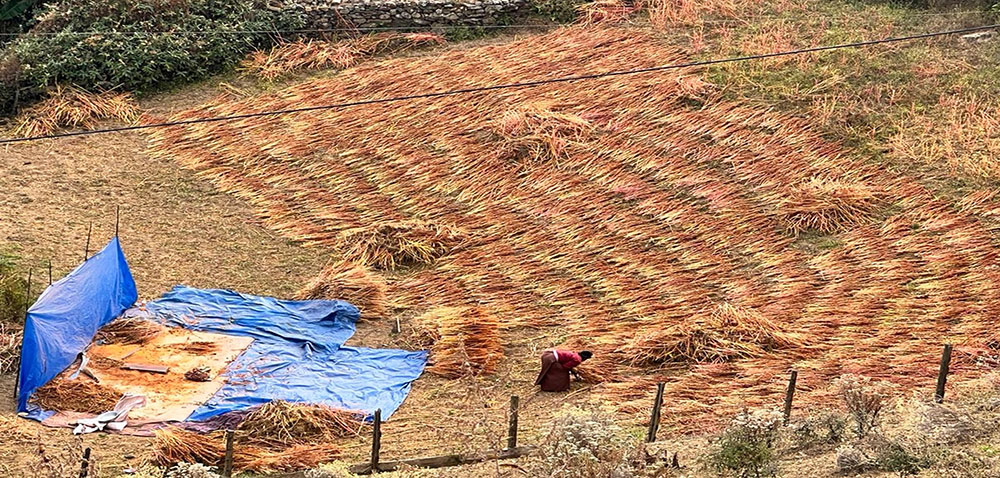
[ad_1]
YK Puddle
Germination problems, timeliness of sowing, post-germination care, knowledge of mechanization, damage caused by rainfall, frost and birds are the major issues facing quinoa cultivation in Bhutan.
These issues were discussed at a two-day quinoa production and breeding workshop held by the National Center for Organic Agriculture (NCOA), attended by 20 quinoa experts from agricultural research centers and related institutions across the country.
The Bhutanese Ministry of Agriculture (DoA), with technical and financial assistance from the Food and Agriculture Organization (FAO) Bhutan Office, has set an ambitious target of producing 250 metric tons of quinoa on 1,000 acres of land in 14 dzongkhags in the first year of the 13th Five-Year Plan.
By the end of the next five years, approximately 4,000 households will be involved, cultivating 4,000 acres of agricultural land and producing 2,360 metric tons of quinoa.
Quinoa, known as Ashi Mo in the east and Rani Bethu in the south, is a nutritious cereal with high export potential and adaptable to different agro-ecological zones. Quinoa can be rotated with crops such as potatoes, maize, rice, wheat and vegetables.

Last year, 223 farmers in the country produced 13 metric tons of quinoa on 28 acres of farmland.
Start from Page 1
In 2020, there were 1,377 quinoa farmers in Bhutan, but market challenges such as low value and low prices discourage farmers from continuing to grow quinoa.
As part of the Flexible Voluntary Contribution (FVC) project titled “Increasing the productivity of priority crops by piloting and scaling up tailored, innovative, climate-resilient and sustainable agricultural practices in South Asian countries”, Bhutan, Bangladesh and Nepal launched a $1 million project in March this year. The project is due to end in December next year.
Bhutan received a grant of US$200,000 from the total FVC project amount, and an additional US$6 million was allocated for training and capacity building.
The country is currently piloting 10% of its total quinoa production in various hospital and school feeding programs with the participation of multiple agencies.
Tirtha Bahadur Katwal, an expert from the National Centre for Organic Agriculture (NCOA) in Yusipang, said that the government has prioritized quinoa as a high-value crop and all research centers and related institutions are working together.
The government has introduced a series of preferential policies, such as giving priority to quinoa for school feeding programs and hospitals, letting the Agricultural Machinery Company Limited act as the integrator, the Ministry of Finance maintaining a price guarantee system, and designating quinoa as a “one country, one product” commodity, making it the top priority crop during the 13th Five-Year Plan period.
“The department’s program focuses on breeding high-yielding, resilient tri-color varieties,” said Tirtha Bahadur Katwal. “Through the Brand Bhutan program, including the Geographical Indication and the Geographical Indication Environmental Sustainability, we aim to promote the unique value of quinoa while taking into account environmental considerations.”
He explained that current initiatives include strategies such as providing seeds for free, buyback at preferential prices, and supporting processing machines. “While there are challenges in the production, post-production and marketing stages, the opportunities in post-production and marketing are bright.”
Quinoa is well suited to the southern lowlands and inland highlands. “The problem at higher altitudes is that the growing season is shorter, but planting at the right time can help get better yields,” he said.
Namgay Wangdi, a quinoa expert who worked at the Onkar Agricultural Research and Development Center, said nine varieties have been tested in the country and four have grown well since their introduction in 2015. “Quinoa grows well in the six southern dzongkhags, especially in the east, where the temperature ranges from 10°C to 38°C.”
So far, agricultural extension officers and about 500 farmers from 19 sects in the east have been trained in quinoa cultivation. Bartsham in Trashigaon is the district with the highest quinoa production.
“Although most farmers in the eastern region have their own seed reserves, the Agricultural Development Center has distributed 2,172.5 kg of seeds so far, leaving 4,827 kg of seeds for interested farmers,” Wangdi said. “The government should provide electric shelling machines to facilitate farmers.”
He also pointed out that the government’s electric and chain-link fencing and irrigation schemes have helped protect crops and boost their growth.
The government has allocated N10.23 billion for the renewable natural resources sector in the fiscal year 2024-25, of which N910.5 million in the 13th Plan is for agricultural marketing and cooperatives. In addition, 100% foreign direct investment in the agricultural sector has been announced since June this year, along with other investment plans.
Quinoa can be used to make about nine different types of food, the most popular of which are quinoa porridge and pancakes.
The seminar, which concluded today, was moderated by experts from the National Academy of Sciences, the Australian Research Council and FAO regional expert Dr Hui Zhang.
[ad_2]
Source link


